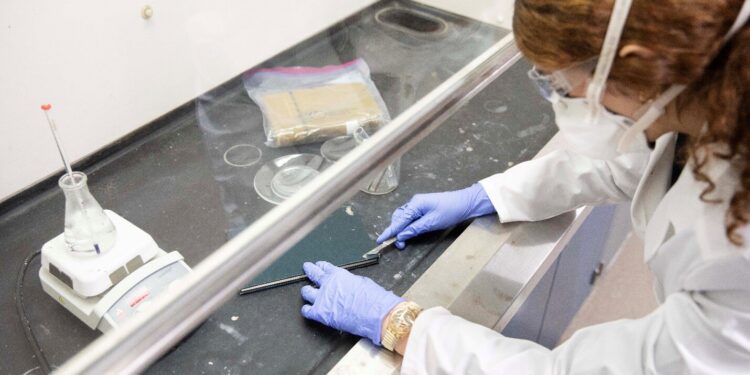Leila Ais cuts out a sample of a book cover to test for toxic dyes. Credit: Kristy Jones
If you come across brightly colored, cloth-bound Victorian books, it’s best to handle them with care or avoid them altogether. Some of their eye-catching hues come from dyes that could pose a health risk to readers, collectors, or librarians.
The latest research into these toxic books used three techniques, including one that had never before been applied to books, to assess dangerous dyes in a university collection and found that some volumes could be dangerous to handle.
The researchers present their results at the fall meeting of the American Chemical Society.
“These old books with toxic dyes can be found in universities, public libraries and private collections,” said Abigail Hoermann, a chemistry student at Lipscomb University. Users can be exposed to risks if pigments from the fabric covers rub onto their hands or become airborne and inhaled.
“So we want to find a way to make it easy for everyone to know how much exposure they’re having to these books and how to store them safely.” Hoermann, Jafer Aljorani, a recent graduate, and Leila Ais, an undergraduate, conducted the study with Joseph Weinstein-Webb, an assistant professor of chemistry at Lipscomb.
The study began after Lipscomb librarians Jan Cohu and Michaela Rutledge contacted the university’s chemistry department to test brightly colored, cloth-covered books from the school’s Beaman Library from the 19th and early 20th centuries. Weinstein-Webb was intrigued to learn that the Winterthur Museum, Garden & Library had already tested its own 19th-century books for an arsenic compound known as copper acetoarsenite.
This emerald green pigment was used in Victorian-era wallpapers and clothing and, as Winterthur discovered, in cloth book covers. That discovery led to the launch of the Poison Book Project, a crowdsourced research effort that uses X-ray fluorescence (XRF), Raman spectroscopy, and other techniques to reveal the presence of toxic pigments in books around the world. Weinstein-Webb and the Lipscomb students he recruited launched their own investigation in 2022.
For the Lipscomb book project, the team used three spectroscopic techniques:
- XRF to qualitatively check whether arsenic or other heavy metals were present in any of the book covers.
- Inductively coupled plasma optical emission spectroscopy (ICP-OES) to determine the concentration of these metals.
- X-ray diffraction (XRD) to identify pigment molecules that contain these metals.
Although XRD has been used to examine paint and wallpaper before, this is the first time it has been used to check books for poison, Ais says. The XRD tests are being conducted in collaboration with Janet Macdonald of Vanderbilt University.
Recently, researchers used X-ray fluorescence data to show that lead and chromium were present in some of Lipscomb’s books. To quantify the amounts, they took paperclip-sized samples from the cloth covers and dissolved them in nitric acid.
Their ICP-OES analysis showed that both lead and chromium were present at high levels in some samples. Subsequent XRD tests indicated that in some cases, these heavy metals were in the form of lead(II) chromate, one of the compounds that contributes to the chrome yellow pigment favored by Vincent van Gogh in his sunflower paintings.
However, the lead content of book covers is much higher than the chromium content, which is somewhat puzzling, since lead(II) chromate contains equal amounts of lead and chromium. The researchers speculate that the dyes used to color the books contain other lead-based pigments that do not contain chromium, such as lead(II) oxide or lead(II) sulfide. The team is working to identify these other compounds in the yellow pigments.
Weinstein-Webb and the students also wanted to know whether the levels of heavy metals in Lipscomb’s books could be harmful to librarians who might handle them. For some book covers, the researchers found metal concentrations above acceptable limits for chronic exposure, according to standards set by the Centers for Disease Control and Prevention (CDC).
In the dissolved sample from the most contaminated blanket, the lead concentration was more than twice the CDC limit, and the chromium concentration was nearly six times the limit. Chronic exposure to inhaled lead or chromium could cause health effects such as cancer, lung damage, or fertility problems.
“I find it fascinating to know what previous generations thought was safe, and then we learn, oh, actually, maybe it wasn’t a good idea to use these bright dyes,” Weinstein-Webb says.
The results of this research led Lipscomb Library to seal untested 19th-century colored books in zip-lock plastic bags for handling and storage. At the same time, books confirmed to contain hazardous dyes were also sealed in bags and removed from public circulation.
Once the researchers conduct further testing, they plan to share their results with the Poison Book Project and help educate librarians and collectors about the safe handling, preservation and storage of these books.
They also hope that others will follow their lead and start using DRX, because it doesn’t require investigators to take samples from books. “In the future,” Hoermann says, “we want libraries to be able to test their collections without destroying them.”
More information:
Multimodal Detection of Toxic Metals in Victorian Book Fabrics from the Beaman Library Collection, ACS Fall 2024.
Provided by the American Chemical Society
Quote:Evidence Mounts for Toxic Books Containing Toxic Dyes (2024, August 18) retrieved August 19, 2024 from
This document is subject to copyright. Apart from any fair dealing for the purpose of private study or research, no part may be reproduced without written permission. The content is provided for informational purposes only.



